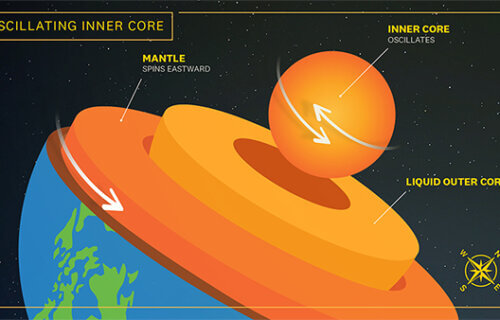LOS ANGELES —The Earth is moving more than 3,000 miles under our feet, according to new research. Its inner core goes back and forth over a mile every six years.
The cycle explains variations in the length of days, which have oscillated for decades.
“From our findings, we can see the Earth’s surface shifts compared to its inner core, as people have asserted for 20 years,” says lead author Professor John Vidale from USC in a university release.
The huge iron ball is roughly the size of Pluto and as hot as the Sun. The California team used seismic data from 1969 to 1974 to create a computer model of it. Simulations contradicted previous theories suggesting consistent rotation faster than at the planet’s surface.
“However, our latest observations show that the inner core spun slightly slower from 1969–71 and then moved the other direction from 1971–74. We also note that the length of day grew and shrank as would be predicted,” Prof. Vidale says. “The coincidence of those two observations makes oscillation the likely interpretation.”
When Jules Verne wrote “A Journey to the Center of the Earth,” he imagined a land of glowing crystals, turbulent seas, prehistoric animals, and giant mushrooms. What was actually beneath our feet was a complete mystery. Even today, we know more about the rings of Saturn than the interior of our planet.
However, that is beginning to change thanks to a golden age of discovery. Our understanding has expanded dramatically in the past 30 years. Earth’s core has been shown to move and change over decades, but it’s impossible to observe directly.
Seismologists rely on indirect measurements to explain pattern, speed, and cause. Utilizing data from the LASA (Large Aperture Seismic Array), a U.S. Air Force facility in Montana, Prof. Vidale found the inner core rotated slower than previously predicted, approximately 0.1 degrees per year.
Lab staff developed a novel beam-forming technique to analyze waves generated from Soviet underground nuclear bomb tests from 1971 to 1974 in the Arctic Archipelago Novaya Zemlya.
The latest results emerged when they applied the same methodology to a pair of earlier atomic tests beneath Amchitka Island at the tip of the Alaskan archipelago – Milrow in 1969 and Cannikin in 1971. Measuring the compressional waves resulting from the nuclear explosions, they discovered the inner core had reversed direction, sub-rotating at least a tenth of a degree per year. It marked the first time the well-known six-year oscillation had been indicated through direct seismological observation.
“The idea the inner core oscillates was a model that was out there, but the community has been split on whether it was viable,” Prof. Vidale explains.
“We went into this expecting to see the same rotation direction and rate in the earlier pair of atomic tests, but instead we saw the opposite,” Vidale says. “We were quite surprised to find that it was moving in the other direction.”
By using seismological data from atomic tests in previous studies, the researchers have been able to pinpoint the exact location and time of the very simple seismic event.
LASA closed in 1978 and the era of U.S. underground atomic testing is over, meaning scientists would need to rely on comparatively imprecise earthquake data, even with recent advances in instrumentation.
The study supports speculation the inner core oscillates based on variations in the length of day – plus or minus 0.2 seconds over six years – and geomagnetic fields, both of which match the theory in both amplitude and phase. It provides a compelling theory for many questions posed by the research community.
“The inner core is not fixed — it’s moving under our feet, and it seems to going back and forth a couple of kilometers every six years,” Vidale concludes.
“One of the questions we tried to answer is, does the inner core progressively move or is it mostly locked compared to everything else in the long term? We’re trying to understand how the inner core formed and how it moves over time — this is an important step in better understanding this process.”
The study is published in the journal Science Advances.
South West News Service writer Mark Waghorn contributed to this report.

